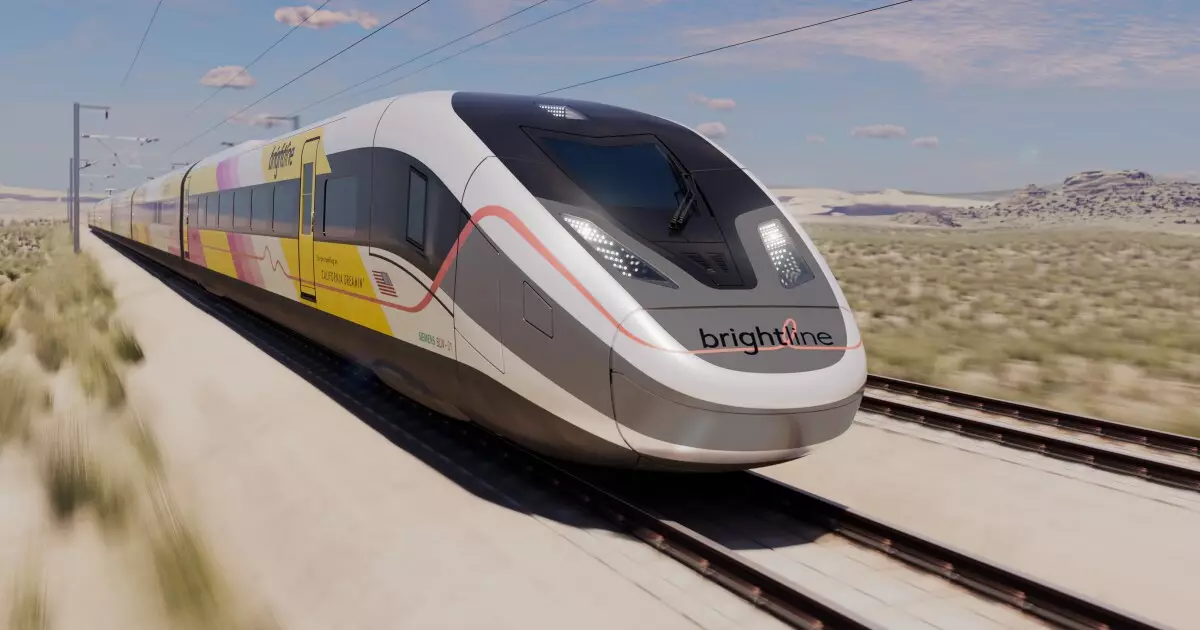The announcement of Brightline West’s ambitious Las Vegas-Los Angeles bullet train project marks a significant milestone in private transportation infrastructure. The recent issuance of $2.5 billion in unrated private activity bonds with enticing yields reflects both the confidence of investors and the potential economic impact of the project. As we delve into the details surrounding this financing endeavor, we will assess its implications for public-private partnerships, the evolving nature of municipal bond markets, and the transportation sector overall.
Understanding the Bond Structure and Market Response
The $2.5 billion bond offering was structured uniquely, featuring a single $2 billion CUSIP — an uncommon strategy in the municipal bond market, which typically relies on multiple tranches to distribute risk. This novel approach, according to market insiders, enhances liquidity – a critical element vital for the attraction of investors. Such structural innovation does not occur frequently within bond issues, especially in the high-yield arena, and suggests that Brightline West is strategically positioning itself in a competitive market.
The overwhelming response from the investment community—over $3.4 billion in orders from 75 accounts—indicates a robust appetite for high-yield municipal bonds, particularly those associated with a forward-looking project such as Brightline West. Jim Lyman from Belle Haven Investments emphasized the appealing combination of liquidity, yield, and a solid economic premise. Investors interested in high-yield opportunities are often balancing risk and return profiles, and this deal seemingly presents an attractive proposition.
Brightline West, under the ownership of Fortress Investment Group, aims to establish the first privately owned, all-electric high-speed rail service in the United States. With a projected budget of $12.4 billion, the current $2.5 billion bond issuance is merely the first step towards securing the total financing needed. The endeavor is particularly timely, coinciding with recent government discussions regarding federal funding, particularly the scrutiny faced by California’s high-speed rail initiative.
However, the ambitious timeline of December 2028 for the project’s operational launch raises questions. While the initial target was aligned with the 2028 Olympic Games, the revised timeline indicates shifts and possible delays. The outlook for securing an additional $6 billion in bank facilities to further finance construction seems optimistic, yet it also carries inherent risks, especially if contingent grants and commitments are hindered by governmental policy shifts.
The financing secured by Brightline West comes at a time when federal support for transportation projects can be highly variable. Recent statements from the Trump administration have praised the project, contrasting it with criticism aimed at the California high-speed rail endeavor—a dynamic that could hinge on political tides. The bipartisan nature of federal grant allocations raises concerns about the long-term viability of funding streams. The $3 billion federal grant received from the Biden administration underscores a supportive financial backdrop; however, the bond documents highlight significant risks related to the uncertainty and conditions surrounding such grants.
Investors must remain vigilant as developments unfold, particularly concerning whether the Biden administration’s allocations remain intact or fall victim to political retribution. The fear of a potential rescindment of these funds could dampen investor enthusiasm, and concerns that funding for Brightline West could be reevaluated under changing political circumstances loom large.
The Future of High-Speed Rail in the U.S.
As Brightline West embarks on this financial journey, its success could herald a new era for high-speed rail in the United States. Despite facing skepticism, the partnership between public bodies and private entities offers a fascinating model for future infrastructure projects. The evolving attitudes towards public transportation, particularly in an era marked by increasing environmental consciousness, bolster the argument for investing in rail alternatives to traditional vehicular transportation.
Moreover, should Brightline West succeed in procuring investment-grade ratings for its bonds after construction, this could set a precedent for future projects and attract a broader spectrum of investors. The cautious sentiment expressed by some investment firms regarding overall structural risks highlights the need for ongoing scrutiny and the establishment of reliable ridership projections — key components in solidifying the economic viability of significant transportation projects.
Brightline West’s bond offering represents much more than a mere financial transaction; it is a potential catalyst for transformative change in American transportation infrastructure. The project’s success hinges not only on investor participation and funding procurement but also on the political landscape and public perception of high-speed rail. As the project advances through the complexities of financing and construction, all eyes will be on the outcome of this venture, which, if successful, could revolutionize the way Americans perceive and utilize rail travel. The implications of this initiative extend beyond California and Nevada; they may redefine urban connectivity across the country.


Leave a Reply